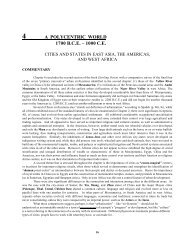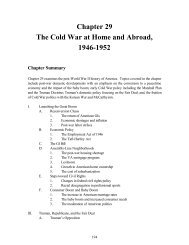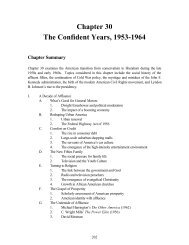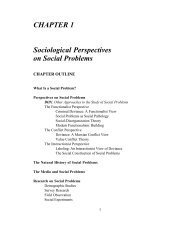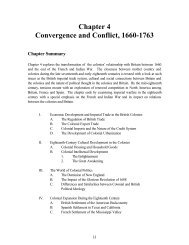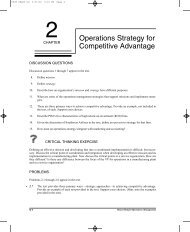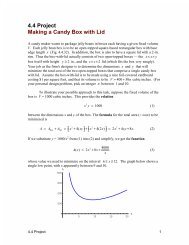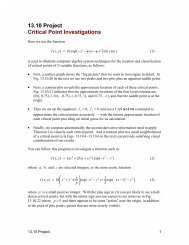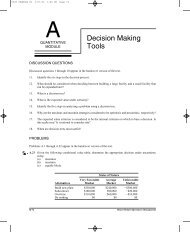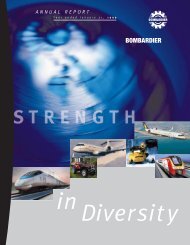Merchandising Operations and the Accounting Cycle - Pearson
Merchandising Operations and the Accounting Cycle - Pearson
Merchandising Operations and the Accounting Cycle - Pearson
You also want an ePaper? Increase the reach of your titles
YUMPU automatically turns print PDFs into web optimized ePapers that Google loves.
The Forzani Group Ltd.<br />
(FGL) is Canada’s largestselling<br />
retailer of sporting<br />
goods. The company<br />
operates its retail stores under<br />
four different banners:<br />
SportChek, Sports Experts,<br />
Forzani’s, <strong>and</strong> Coast Mountain<br />
Sports.<br />
“FGL has redefined <strong>the</strong><br />
concept of sporting goods retailing<br />
by migrating <strong>the</strong> experience<br />
to one focussed on an<br />
active lifestyle.” Indeed, <strong>the</strong> company recovered from<br />
near-bankruptcy in <strong>the</strong> mid-1990s to become one of <strong>the</strong><br />
most successful retailers in <strong>the</strong> country. The company<br />
operates over 130 corporate stores <strong>and</strong> 165 franchised<br />
stores with over 46,000 product items available. FGL has<br />
defined its target markets <strong>and</strong> is taking strategic initiatives<br />
to ensure success.<br />
One such initiative is to deliver <strong>the</strong> “customer experience”<br />
at <strong>the</strong> lowest possible cost. To achieve this initia-<br />
The Forzani Group Ltd.<br />
www.forzanigroup.com<br />
The Bay<br />
www.hbc.com<br />
Canadian Tire<br />
www.canadiantire.com<br />
Petro-Canada<br />
www.petro-canada.ca<br />
Molson Breweries<br />
www.molson.com<br />
222 Part One The Basic Structure of <strong>Accounting</strong><br />
tive, <strong>the</strong> company must successfully<br />
manage its inventory,<br />
which accounted for 55 percent<br />
of its total assets in fiscal<br />
year 2000. Inventory<br />
management for retailers, like<br />
FGL, is critical to <strong>the</strong>ir success.<br />
SportChek wants to ensure<br />
that it has enough<br />
inventory on h<strong>and</strong> <strong>and</strong> <strong>the</strong><br />
“right” products to meet <strong>the</strong><br />
needs of its customers. At <strong>the</strong><br />
same time, too much inventory<br />
or <strong>the</strong> “wrong” products in inventory can cause cashflow<br />
problems. Advances in computer systems have<br />
helped companies manage <strong>the</strong>ir inventory by providing<br />
up-to-date inventory data in real time.<br />
FGL recognizes <strong>the</strong> potential changes in buying habits<br />
that <strong>the</strong> internet will bring. To this end, FGL is creating<br />
its own website to take advantage of e-commerce<br />
retailing.<br />
Source: The Forzani Group Ltd. 2000 Annual Report.<br />
CHAPTER 5<br />
comes to mind when you think of merch<strong>and</strong>ising? You probably think<br />
of <strong>the</strong> clothing that you purchase from a department store, <strong>the</strong> bread you buy at<br />
<strong>the</strong> grocery store, or <strong>the</strong> gas you purchase at your local service station. In addition<br />
to SportChek <strong>and</strong> Sports Experts stores, o<strong>the</strong>r merch<strong>and</strong>isers include Zellers, The Bay,<br />
Canadian Tire, Petro-Canada, <strong>and</strong> Shoppers Drug Mart.<br />
How do <strong>the</strong> operations of The Forzani Group Ltd. <strong>and</strong> o<strong>the</strong>r merch<strong>and</strong>isers differ<br />
from those of <strong>the</strong> businesses we have studied so far? In <strong>the</strong> first four chapters, Air<br />
& Sea Travel, Inc. provided an illustration of a business that earns revenue by selling<br />
its services. Service enterprises include Four Seasons Hotels, Air Canada, physicians,<br />
lawyers, public accountants, <strong>the</strong> Vancouver Canucks hockey club, <strong>and</strong> <strong>the</strong><br />
twelve-year-old who cuts lawns in your neighbourhood. A merch<strong>and</strong>ising entity<br />
earns its revenue by selling products, called merch<strong>and</strong>ise inventory or, simply, inventory.<br />
This chapter demonstrates <strong>the</strong> central role of inventory in a business that sells merch<strong>and</strong>ise.<br />
Inventory includes all goods that <strong>the</strong> company owns <strong>and</strong> expects to sell<br />
in <strong>the</strong> normal course of operations. Some businesses, such as Zellers department<br />
stores, Petro-Canada gas stations, <strong>and</strong> Safeway grocery stores, buy <strong>the</strong>ir inventory<br />
in finished form ready for sale to customers. O<strong>the</strong>rs, such as Bombardier <strong>and</strong> Molson<br />
Breweries, manufacture <strong>the</strong>ir own products. Both groups sell products ra<strong>the</strong>r than<br />
services.<br />
We illustrate accounting for <strong>the</strong> purchase <strong>and</strong> sale of inventory, how to adjust <strong>and</strong><br />
close <strong>the</strong> books of a merch<strong>and</strong>iser <strong>and</strong> how to prepare financial statements for a merch<strong>and</strong>iser.<br />
The chapter illustrates both <strong>the</strong> perpetual <strong>and</strong> periodic inventory methods.<br />
The chapter covers two ratios that investors <strong>and</strong> creditors use to evaluate companies.<br />
What



